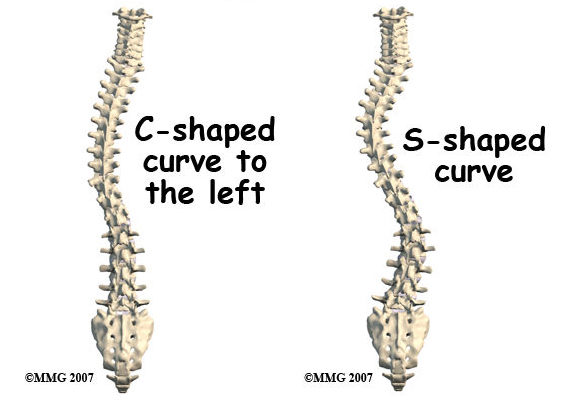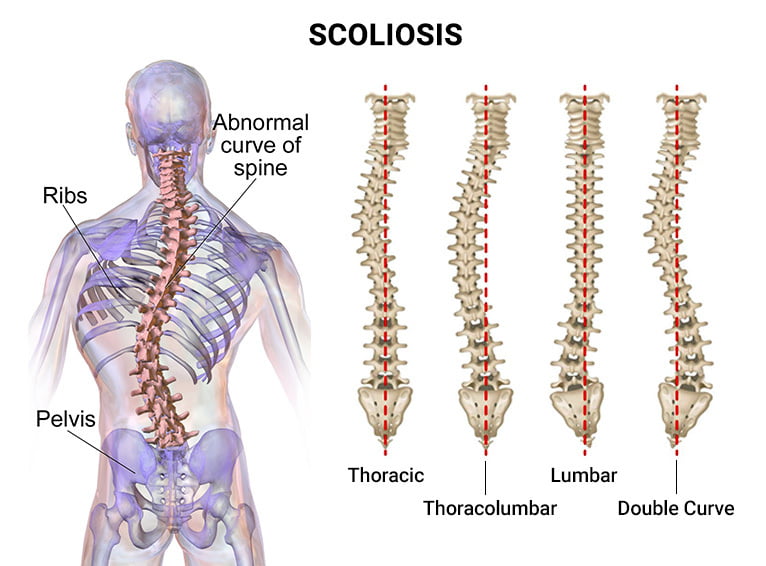Scoliosis is a condition that affects the curvature of the spine, causing it to curve sideways. It is a complex condition that can have a significant impact on a person’s daily life. In this article, we will explore various aspects of scoliosis, including its prevalence, age of onset, gender differences, causes, types, symptoms, diagnosis, treatment options, impact on daily life, mental health implications, and advancements in treatment.

What is Scoliosis?
Scoliosis is a medical condition characterized by an abnormal curvature of the spine. Instead of the spine being straight, it curves sideways, forming an “S” or “C” shape. This curvature can occur in any part of the spine, including the upper back (thoracic), lower back (lumbar), or both. Scoliosis can range from mild to severe, and its severity can vary from person to person.

Prevalence of Scoliosis
Scoliosis is more common than you might think. According to the Scoliosis Research Society, approximately 2-3% of the population has scoliosis. This means that millions of people worldwide are affected by this condition. It can occur at any age, but it is most commonly diagnosed during adolescence.
Age of Onset
While scoliosis can occur at any age, it is most commonly diagnosed during adolescence. The majority of scoliosis cases are classified as idiopathic, meaning the cause is unknown. Idiopathic scoliosis typically develops between the ages of 10 and 18, with the most rapid progression occurring during growth spurts. However, scoliosis can also develop in infants (known as infantile scoliosis) or adults (known as adult-onset scoliosis).
Gender Differences in Scoliosis
There is a notable gender difference in the prevalence of scoliosis. It is more common in females than males, with a female-to-male ratio of approximately 3:1. The reasons for this gender difference are not fully understood, but hormonal and genetic factors are believed to play a role. Hormonal changes during puberty may contribute to the increased prevalence of scoliosis in females.
Causes of Scoliosis
The exact causes of scoliosis are still not fully understood. As mentioned earlier, most cases of scoliosis are classified as idiopathic, meaning the cause is unknown. However, there are several known causes of scoliosis, including congenital abnormalities, neuromuscular conditions (such as cerebral palsy or muscular dystrophy), and genetic factors. In some cases, scoliosis may also be caused by trauma or injury to the spine.
Types of Scoliosis
Scoliosis can be classified into different types based on its cause and age of onset. The most common types include idiopathic scoliosis, congenital scoliosis, neuromuscular scoliosis, and degenerative scoliosis. Idiopathic scoliosis is the most common type and has no known cause. Congenital scoliosis is present at birth and is caused by abnormal spinal development. Neuromuscular scoliosis is associated with underlying neuromuscular conditions, while degenerative scoliosis occurs due to age-related changes in the spine.

Symptoms and Warning Signs
The symptoms of scoliosis can vary depending on the severity of the curvature. In mild cases, there may be no noticeable symptoms, while in severe cases, symptoms may include an uneven waistline, one shoulder higher than the other, a prominent rib cage, or a noticeable curve in the spine. Some individuals may also experience back pain, muscle stiffness, or difficulty breathing if the curvature affects the chest area.
Diagnosis and Screening Methods
Early detection and diagnosis of scoliosis are crucial for effective treatment. Screening for scoliosis typically involves a physical examination, where a healthcare professional will assess the curvature of the spine and look for any signs of scoliosis. If scoliosis is suspected, further diagnostic tests such as X-rays, MRI scans, or CT scans may be performed to determine the severity and type of scoliosis.
Treatment Options for Scoliosis
The treatment options for scoliosis depend on various factors, including the severity of the curvature, the age of the individual, and the underlying cause of scoliosis. In mild cases, regular monitoring and observation may be sufficient. However, in more severe cases, treatment options may include bracing, physical therapy, or surgery. Bracing is often recommended for adolescents with moderate scoliosis to prevent further progression of the curvature. Physical therapy can help improve posture, strengthen muscles, and alleviate pain. In severe cases, surgery may be necessary to correct the curvature and stabilize the spine.
Impact of Scoliosis on Daily Life
Living with scoliosis can have a significant impact on a person’s daily life. The physical symptoms, such as pain and limited mobility, can affect one’s ability to perform daily activities, participate in sports, or even sit or stand for extended periods. Scoliosis can also impact body image and self-esteem, especially in adolescents who may feel self-conscious about their appearance. It is important to provide support and resources to individuals with scoliosis to help them manage the physical and emotional challenges associated with the condition.
Scoliosis and Mental Health
The impact of scoliosis on mental health should not be overlooked. Studies have shown that individuals with scoliosis are at a higher risk of developing psychological issues such as anxiety and depression. The visible physical deformity and the challenges associated with managing scoliosis can contribute to feelings of self-consciousness, isolation, and low self-esteem. It is crucial to address the mental health needs of individuals with scoliosis and provide them with appropriate support and resources.
Research and Advancements in Scoliosis Treatment
Advancements in scoliosis treatment have come a long way in recent years. Researchers are constantly exploring new treatment options and techniques to improve outcomes for individuals with scoliosis. One area of focus is the development of non-surgical interventions, such as innovative bracing techniques and exercises tailored to specific types of scoliosis. Additionally, advancements in surgical techniques, such as minimally invasive procedures, have reduced the invasiveness and recovery time associated with scoliosis surgery. These advancements offer hope for improved treatment outcomes and quality of life for individuals with scoliosis.
In conclusion, scoliosis is a complex condition that affects the curvature of the spine. It can occur at any age, but it is most commonly diagnosed during adolescence. Scoliosis is more prevalent in females, and while the exact causes are unknown in most cases, there are known risk factors such as genetic factors and underlying neuromuscular conditions. Early detection and diagnosis are crucial for effective treatment, and treatment options range from observation and bracing to physical therapy and surgery. Scoliosis can have a significant impact on daily life, both physically and mentally, and it is important to provide support and resources to individuals with scoliosis. Advancements in research and treatment offer hope for improved outcomes and quality of life for those affected by scoliosis.
References
- Weinstein, S. L., Dolan, L. A., Wright, J. G., Dobbs, M. B. (2013). Effects of bracing in adolescents with idiopathic scoliosis. New England Journal of Medicine, 369(16), 1512-1521. Available at: https://www.nejm.org/doi/full/10.1056/NEJMoa1307337
- Asher, M. A., Burton, D. C. (2006). Adolescent idiopathic scoliosis: Natural history and long-term treatment effects. Scoliosis, 1(1), 2. Available at: https://scoliosisjournal.biomedcentral.com/articles/10.1186/1748-7161-1-2
- Cheng, J. C. Y., Castelein, R. M., Chu, W. C. W., Danielsson, A. J., Dobbs, M. B., Grivas, T. B., … & Tjernström, B. (2015). Adolescent idiopathic scoliosis. Nature Reviews Disease Primers, 1, 15030. Available at: https://www.nature.com/articles/nrdp201530
- Lonstein, J. E., Carlson, J. M. (1984). The prediction of curve progression in untreated idiopathic scoliosis during growth. The Journal of Bone and Joint Surgery, 66(7), 1061-1071. Available at: https://journals.lww.com/jbjsjournal/Abstract/1984/66070/The_Prediction_of_Curve_Progression_in_Untreated.3.aspx
- Negrini, S., Donzelli, S., Aulisa, A. G., Czaprowski, D., Schreiber, S., De Mauroy, J. C., … & Zaina, F. (2018). 2016 SOSORT guidelines: orthopaedic and rehabilitation treatment of idiopathic scoliosis during growth. Scoliosis and Spinal Disorders, 13(1), 3. Available at: https://scoliosisjournal.biomedcentral.com/articles/10.1186/s13013-017-0145-8
- Shands, A. R., Eisberg, H. B. (1955). The incidence of scoliosis in the state of Delaware; a study of 50,000 minifilms of the chest made during a survey for tuberculosis. The Journal of Bone and Joint Surgery. American Volume, 37(6), 1243-1249. Available at: https://journals.lww.com/jbjsjournal/Abstract/1955/37060/The_Incidence_of_Scoliosis_in_the_State_of_Delaware.1.aspx
- Montgomery, F., Willner, S. (1974). Prognosis of scoliosis in the adult. The Journal of Bone and Joint Surgery. British Volume, 56(4), 628-630. Available at: https://journals.lww.com/jbjsjournal/Abstract/1974/56040/Prognosis_of_Scoliosis_in_the_Adult.1.aspx
- Danielsson, A. J., Nachemson, A. L. (2001). Childbearing, curve progression, and sexual function in women with idiopathic scoliosis. Spine, 26(18), E449-E454. Available at: https://journals.lww.com/spinejournal/Abstract/2001/09150/Childbearing,_Curve_Progression,_and_Sexual.5.aspx
- Watanabe, K., Hasegawa, K., Hirano, T., Uchiyama, S., Ito, T., Morita, O., & Endo, N. (2010). Impact of scoliosis on the psychological health of patients with adolescent idiopathic scoliosis in Japan. Spine, 35(8), E410-E414. Available at: https://journals.lww.com/spinejournal/Abstract/2010/04150/Impact_of_Scoliosis_on_the_Psychological_Health_of.20.aspx
- Reamy, B. V., Slakey, J. B. (2001). Adolescent idiopathic scoliosis: review and current concepts. American Family Physician, 64(1), 111-116. Available at: https://www.aafp.org/pubs/afp/issues/2001/0701/p111.html
- Kuno, H., Kataoka, O., Takenouchi, H., Sugita, M., Ohura, T. (1991). Psychological factors in scoliosis surgery. Spine, 16(10), 1151-1156. Available at: https://journals.lww.com/spinejournal/Abstract/1991/10160/Psychological_Factors_in_Scoliosis_Surgery.15.aspx
- Lowe, T. G., Edgar, M., Margulies, J. Y., Miller, N. H., Raso, V. J., Reinker, K. A., & Rivard, C. H. (2000). Etiology of idiopathic scoliosis: current trends in research. The Journal of Bone and Joint Surgery. American Volume, 82(8), 1157-1168. Available at: https://journals.lww.com/jbjsjournal/Abstract/2000/08000/Etiology_of_Idiopathic_Scoliosis__Current_Trends.17.aspx

